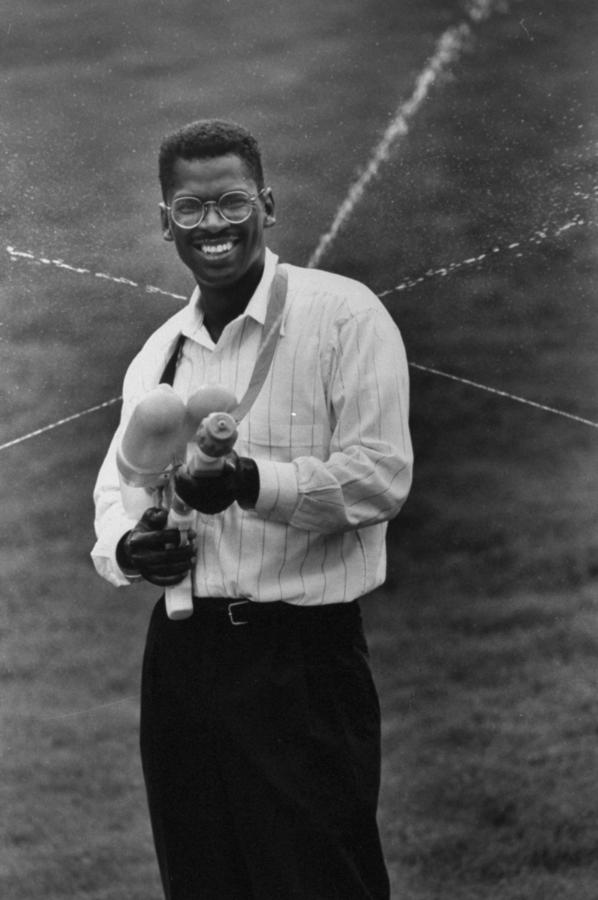Lonnie Johnson at a Glance
- Categories: Business, Business > Executives
- Net Worth: $200 Million
- Birthdate: Oct 6, 1949 (74 years old)
- Birthplace: Mobile
- Gender: Male
- Profession: Inventor
- Nationality: United States of America
Lonnie Johnson: From NASA Engineer to Super Soaker Billionaire
What is Lonnie Johnson’s Net Worth?
Lonnie Johnson is an American engineer, inventor, and entrepreneur celebrated for his groundbreaking inventions, most notably the Super Soaker water gun. His ingenious inventions have resulted in considerable financial success, with a net worth estimated at $200 million. Johnson’s wealth is a testament to his innovative spirit and entrepreneurial acumen, with a large portion of his earnings stemming from the immense popularity and global sales of the Super Soaker, which has generated over $2 billion in revenue since its inception.
Early Life and Education
Born in Mobile, Alabama, in October 1949, Lonnie George Johnson displayed exceptional intellectual capabilities from an early age. Even as a young child, his parents recognized his innate aptitude for engineering and invention. Johnson’s fascination with building and creating was evident early on. By the age of 10, he had built a fully functional go-kart, demonstrating an impressive level of mechanical skill and determination. This early display of innovation, however, led to a humorous incident when local authorities confiscated the go-kart after finding young Lonnie driving it on the road.
In 1968, Johnson’s talent was further recognized when he won the Alabama State Science Fair. His winning project was a compressed-air-powered robot constructed from materials salvaged from a junkyard, showcasing his ability to create sophisticated technology using limited resources. Johnson pursued higher education at Tuskegee University, where he earned a Bachelor of Science degree in Mechanical Engineering and a Master of Science degree in Nuclear Engineering. This rigorous academic background laid the foundation for his future achievements in engineering and invention.
A Distinguished Career at NASA
After completing his education, Lonnie Johnson joined the United States Air Force, where he contributed his engineering expertise to the development of advanced technologies, including projects related to the Stealth Bomber. This experience provided him with valuable insights into cutting-edge engineering practices. Subsequently, Johnson was recruited by NASA’s Jet Propulsion Laboratory (JPL), where he worked as a Senior Systems Engineer. His role at JPL placed him at the forefront of several pivotal space missions. He was a key member of the engineering teams behind the Galileo mission to Jupiter, the Cassini mission to Saturn, and the Mars Observer project. His work on these missions involved complex problem-solving and a deep understanding of aerospace engineering.
In addition to his work at NASA, Johnson remained highly active in pursuing his personal inventions, amassing a portfolio of over 100 patents. This prolific inventive output underscores his dedication to innovation and his ability to generate new ideas and solutions across a range of fields.
The Accidental Genesis of the Super Soaker
The genesis of Lonnie Johnson’s most famous invention, the Super Soaker, was almost entirely accidental. In 1982, Johnson was working on a project to develop a new type of water pump, envisioning a system that could use water under pressure instead of Freon to circulate chilled water in refrigerators. His goal was to create a more efficient and environmentally friendly cooling system. One evening, while experimenting with a prototype of this heat pump in his bathroom, Johnson made a remarkable discovery. As he tested the device by directing a stream of water across the room, he realized the potential of the pump’s powerful stream. As Johnson himself recounted, “I turned around and I was shooting this thing across the bathroom into the tub and the stream of water was so powerful that the curtains were swirling in the breeze it sent out. I thought, ‘This would make a great water gun.'”
This moment of inspiration led to a radical new concept for a toy water gun, one that departed significantly from existing designs. Unlike conventional squirt guns of the time, the Super Soaker employed a hand pump to generate air pressure, which could propel a concentrated stream of water over distances of 20 to 30 feet. This innovative approach set the Super Soaker apart from its predecessors and contributed to its massive success.
Super Soaker’s Rise to Global Phenomenon
Despite his groundbreaking invention, Johnson faced significant challenges in bringing the Super Soaker to market. Lacking the financial resources to commercialize the product himself, he initially sought to license his invention. However, his initial partnership did not yield the desired results. Johnson persevered, eventually forming a strategic partnership with the toy company Larami. Larami took the Super Soaker into mass production in 1989. The first version of the gun, introduced under the name “Power Drencher,” initially struggled to gain traction. The marketing efforts for the Power Drencher were minimal, leading to disappointing sales in 1990. Recognizing the need for a stronger brand identity and a more effective marketing strategy, Larami renamed the product the “Super Soaker” and launched a comprehensive television advertising campaign in 1991.
The relaunch proved to be a resounding success. The Super Soaker quickly became a cultural phenomenon, dominating the toy market and capturing the imagination of children worldwide. For three consecutive years, from 1991 to 1993, the Super Soaker was the best-selling toy in the United States, with sales figures far exceeding its competitors. In 1991 alone, the Super Soaker generated an impressive $200 million in revenue. Over the first decade of the Super Soaker’s production, Larami sold over 200 million units of the water gun, generating over a billion dollars in revenue. The Super Soaker’s success has solidified its place as one of the most iconic and commercially successful toys of all time, changing the landscape of children’s play and establishing Lonnie Johnson as a highly successful inventor and entrepreneur.
Royalties, Earnings, and a Legal Victory
Lonnie Johnson’s financial rewards from the Super Soaker’s phenomenal success were primarily derived from royalties, the percentage of sales he received for each unit sold. As a result of the massive sales volume, Johnson earned hundreds of millions of dollars in royalties over three decades, transforming the Super Soaker from a simple toy into a major revenue stream. His earnings demonstrated the significant financial returns that can be achieved through successful inventions and effective licensing agreements. Later, the Super Soaker became part of the Hasbro portfolio through acquisition. This change, however, led to a dispute regarding royalty payments.
Johnson filed a lawsuit against Hasbro, alleging that the company had failed to pay him the royalties he was owed. After a legal battle, a judge ruled in Johnson’s favor, ordering Hasbro to pay him a lump sum of $73 million to cover royalties that were due between 2007 and 2012. This legal victory underscored the importance of protecting intellectual property rights and enforcing contractual agreements. It also highlighted the significant financial impact that successful inventions can have on their creators.

Lonnie Johnson in 1992 (Photo by Thomas S. England/Getty Images)
Beyond the Super Soaker: Entrepreneurial Ventures
Lonnie Johnson has pursued various entrepreneurial ventures that reflect his continued commitment to innovation and his interest in addressing significant technological challenges. He founded Excellatron, a company that developed the next generation of rechargeable batteries. This venture demonstrated Johnson’s ability to identify emerging technologies and develop practical solutions for improving everyday life. Johnson’s second company, Johnson Electro-Mechanical Systems, pioneered the Johnson Thermo-Electrochemical Converter System (JTEC). The JTEC system converts thermal energy into electric energy by pushing hydrogen ions through membranes, creating a potential solution for harnessing solar and thermal power. This project highlights Johnson’s commitment to sustainable energy solutions and his vision for transforming the way energy is produced and utilized.
Personal Life and Philanthropic Endeavors
Lonnie Johnson and his wife, Linda, have four children and reside in suburban Atlanta. The family life has remained private, emphasizing Johnson’s focus on his work and inventions. Johnson’s commitment extends beyond his professional achievements into philanthropic endeavors. He actively participates in community and charitable organizations, including serving on the Board of Directors of the Georgia Alliance for Children. He is also a board member of the Hank Aaron “Chasing the Dream” Foundation, an organization that supports youth in pursuing their educational and athletic aspirations. Johnson’s philanthropic involvement reflects his desire to give back to the community and support educational opportunities. His activities demonstrate a commitment to improving the lives of others, particularly children, and inspiring the next generation of inventors and innovators. He currently holds over 250 patents, a testament to his continuous innovation.
/**/
Lonnie Johnson’s Enduring Legacy
Lonnie Johnson’s legacy is one of innovation, determination, and entrepreneurial success. His achievements span diverse fields, including engineering, space exploration, and consumer products. The Super Soaker’s massive global impact as a toy has cemented Johnson’s place in popular culture and created substantial financial wealth. Beyond his inventions, Johnson has been a strong advocate for education and philanthropic causes, demonstrating his commitment to improving the lives of others. His career serves as an inspiration to aspiring inventors and entrepreneurs. Through his inventions, his business acumen, and his philanthropic work, Lonnie Johnson has left a lasting impact on both technology and society, establishing a legacy that continues to influence and inspire future generations.

